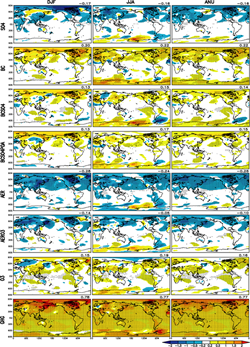Climatic effects of air pollutants over China
Date:2014-10-09
Tropospheric O3 and aerosols are major air pollutants in the atmosphere that have adverse effects on human health, crops, plants, and atmospheric visibility. They have also made significant contributions to radiative forcing of climate since preindustrial times. With its rapid economic development, concentrations of air pollutants are relatively high in China; hence, quantifying the role of air pollutants in China in regional climate change is especially important. Prof. LIAO Hong and her team at the Institute of Atmospheric Physics/Chinese Academy of Sciences, recently published a review to summarize existing knowledge with regard to impacts of air pollutants on climate change in China and define critical gaps needed to reduce the associated uncertainties.
In this work, they compiled measured monthly, seasonal, and annual mean surface-layer concentrations of O3 and aerosols over China, with the aim to show the magnitude of concentrations of O3 and aerosols over China and to provide datasets for evaluation of model results in future studies. Ground-based and satellite measurements of O3 column burden and aerosol optical properties, as well as model estimates of radiative forcing by tropospheric O3 and aerosols are summarized.
Estimates of the climatic effects of air pollutants have to rely on climate models. The commonly used approach to quantify the climatic effects of air pollutants is shown in Fig. 1. Concentrations of air pollutants are simulated in coupled chemistry--aerosol--climate models using emissions inventories, and then optical properties of tropospheric O3, aerosols, and clouds are calculated depending on the chemical and physical properties of air pollutants. The team also reviewed regional and global modeling studies that have investigated climate change driven by tropospheric O3 and/or aerosols in China; the predicted sign and magnitude of the responses in temperature and precipitation to O3/aerosol forcings are presented (Fig. 2 and Fig. 3). Based on this review, key priorities for future research on the climatic effects of air pollutants in China are highlighted.
Summary Slideshow

Fig. 1. Approach for estimating the climatic effects of air pollutants.

Fig. 2. Predicted changes in December--January--February (DJF), June--July--August (JJA), and annual averaged surface air temperature (K) over the period 1950–2000 by different aerosol species, O3, and GHGs. Dotted areas denote results that pass the t-test at the 95% confidence level. The global mean value is indicated in the top right corner of each panel. (Source: Chang et al., 2009).

Fig. 3. Predicted changes in December--January--February (DJF), June--July--August (JJA), and annual averaged precipitation (mm d?1) over the period 1950--2000 by different aerosol species, O3, and GHGs. Dotted areas denote results that pass the t-test at the 95% confidence level. The global mean value is indicated in the top right corner of each panel. (Source: Chang et al., 2009).
Related reading:
Liao, H., W. Y. Chang, and Y. Yang, 2015: Climatic effects of air pollutants over China: A review. Adv. Atmos. Sci., 32(1), doi: 10.1007/s00376-014-0001-1.
Download: http://159.226.119.58/aas/EN/abstract/abstract2567.shtml
